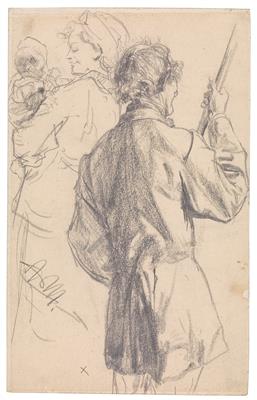Adolph von Menzel

(Breslau 1815–1905 Berlin)
A flag- or lantern-bearer and a woman with a child in her arm, preliminary study for the „Prozession in Hofgastein“, ca. 1879, monogrammed A M., pencil on papewr, 25,2 x 15,8 cm, mounted, unframed, (Sch)
Provenance:
Collection Dr. Julius Mannaberg (1860-1941), Vienna;
by way of inheritance to the widow Leopoldine Mannaberg (1903-1996), Vienna;
1944 compulsary sale by the antiquarian V.A. Heck to Gottfried Reimer for the special order Linz;
depot of the Bundesdenkmalamt, Löwelstraße, Vienna (No 61);
In 1963 allocated to the Albertina, Vienna; since 1965 Albertina Inv.No 34802; 2014 Restitution to the heirs in the succession of Leopoldine Mannaberg.
Between 1872 and 1874 and in 1879 Adolph von Menzel sojourned several weeks in Hofgastein, where he stayed in the house of the befriended banker Magnus Herrmann and the painter Albert Hertel, who was Herrmann’s son in law and lived together with the family of his sister. Magnus Herrmann provided the painter with a studio in the garden house of the estate, where Menzel executed several studies of the village and its people. The present study may date to the time of Menzel’s last sojourn in Hofgastein in 1879. It probably prepared his painting “Procession in Hofgastein”. It may be a preliminary study for one of the lantern- or flag-bearers and for the woman with child in the left foreground of the painting. When Menzel painted the figures he changed the study’s urban costumes into rural costumes. The painting, which was also known under the title “Corpus Christi procession in Hofgastein”, is kept in the Neue Pinakothek in Munich (Inv. L 817) today. When presented in exhibitions the painting aroused heated debates in the 1880s and 1890s. The critics praised the skillful painterly realization of the theme, but discovered in the painting more than a positive description of popular piety on a catholic holiday in a rural ambiente. The figures seem detached from the religious event; they turn away from the procession and suggest a somewhat liberal indifference towards the celebration. Menzel commented on the social and confessional dichotomy of Germany at his time, when he juxtaposed the participants of the procession and those who just watch and observe or are randomly present in the scene.
Esperta: Mag. Astrid-Christina Schierz
 Mag. Astrid-Christina Schierz
Mag. Astrid-Christina Schierz
+43-1-515 60-546
astrid.schierz@dorotheum.at
22.04.2021 - 15:27
- Prezzo realizzato: **
-
EUR 12.800,-
- Stima:
-
EUR 10.000,- a EUR 15.000,-
- Prezzo di partenza:
-
EUR 10.000,-
Adolph von Menzel
(Breslau 1815–1905 Berlin)
A flag- or lantern-bearer and a woman with a child in her arm, preliminary study for the „Prozession in Hofgastein“, ca. 1879, monogrammed A M., pencil on papewr, 25,2 x 15,8 cm, mounted, unframed, (Sch)
Provenance:
Collection Dr. Julius Mannaberg (1860-1941), Vienna;
by way of inheritance to the widow Leopoldine Mannaberg (1903-1996), Vienna;
1944 compulsary sale by the antiquarian V.A. Heck to Gottfried Reimer for the special order Linz;
depot of the Bundesdenkmalamt, Löwelstraße, Vienna (No 61);
In 1963 allocated to the Albertina, Vienna; since 1965 Albertina Inv.No 34802; 2014 Restitution to the heirs in the succession of Leopoldine Mannaberg.
Between 1872 and 1874 and in 1879 Adolph von Menzel sojourned several weeks in Hofgastein, where he stayed in the house of the befriended banker Magnus Herrmann and the painter Albert Hertel, who was Herrmann’s son in law and lived together with the family of his sister. Magnus Herrmann provided the painter with a studio in the garden house of the estate, where Menzel executed several studies of the village and its people. The present study may date to the time of Menzel’s last sojourn in Hofgastein in 1879. It probably prepared his painting “Procession in Hofgastein”. It may be a preliminary study for one of the lantern- or flag-bearers and for the woman with child in the left foreground of the painting. When Menzel painted the figures he changed the study’s urban costumes into rural costumes. The painting, which was also known under the title “Corpus Christi procession in Hofgastein”, is kept in the Neue Pinakothek in Munich (Inv. L 817) today. When presented in exhibitions the painting aroused heated debates in the 1880s and 1890s. The critics praised the skillful painterly realization of the theme, but discovered in the painting more than a positive description of popular piety on a catholic holiday in a rural ambiente. The figures seem detached from the religious event; they turn away from the procession and suggest a somewhat liberal indifference towards the celebration. Menzel commented on the social and confessional dichotomy of Germany at his time, when he juxtaposed the participants of the procession and those who just watch and observe or are randomly present in the scene.
Esperta: Mag. Astrid-Christina Schierz
 Mag. Astrid-Christina Schierz
Mag. Astrid-Christina Schierz
+43-1-515 60-546
astrid.schierz@dorotheum.at
|
Hotline dell'acquirente
lun-ven: 10.00 - 17.00
kundendienst@dorotheum.at +43 1 515 60 200 |
| Asta: | Disegni e stampe fino al 1900, acquarelli e miniature |
| Tipo d'asta: | Asta online |
| Data: | 22.04.2021 - 15:27 |
| Luogo dell'asta: | Wien | Palais Dorotheum |
| Esposizione: | online |
** Prezzo d’acquisto comprensivo dei diritti d’asta acquirente e IVA
Non è più possibile effettuare un ordine di acquisto su Internet. L'asta è in preparazione o è già stata eseguita.
